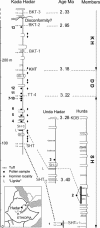High-resolution vegetation and climate change associated with Pliocene Australopithecus afarensis
- PMID: 15304655
- PMCID: PMC514445
- DOI: 10.1073/pnas.0401709101
High-resolution vegetation and climate change associated with Pliocene Australopithecus afarensis
Abstract
Plio-Pleistocene global climate change is believed to have had an important influence on local habitats and early human evolution in Africa. Responses of hominin lineages to climate change have been difficult to test, however, because this procedure requires well documented evidence for connections between global climate and hominin environment. Through high-resolution pollen data from Hadar, Ethiopia, we show that the hominin Australopithecus afarensis accommodated to substantial environmental variability between 3.4 and 2.9 million years ago. A large biome shift, up to 5 degrees C cooling, and a 200- to 300-mm/yr rainfall increase occurred just before 3.3 million years ago, which is consistent with a global marine delta(18)O isotopic shift.
Figures



References
-
- Vrba, E. S., Denton, G. H., Partridge, T. C. & Burckle, L. H., eds. (1995) Paleoclimate and Evolution, with Emphasis on Human Origins (Yale Univ. Press, New Haven, CT).
-
- deMenocal, P. B. (1995) Science 270, 53-59. - PubMed
-
- Potts, R. (1998) Yrb. Phys. Anthropol. 41, 93-136. - PubMed
-
- WoldeGabriel, G., White, T. D., Suwa, G., Renne, P., de Heinzelin, J., Hart, W. K. & Heiken, G. (1994) Nature 371, 330-333. - PubMed
-
- Behrensmeyer, A. K., Todd, N. E., Potts, R. & McBrinn, G. E. (1997) Science 278, 1589-1594. - PubMed
Publication types
MeSH terms
LinkOut - more resources
Full Text Sources

